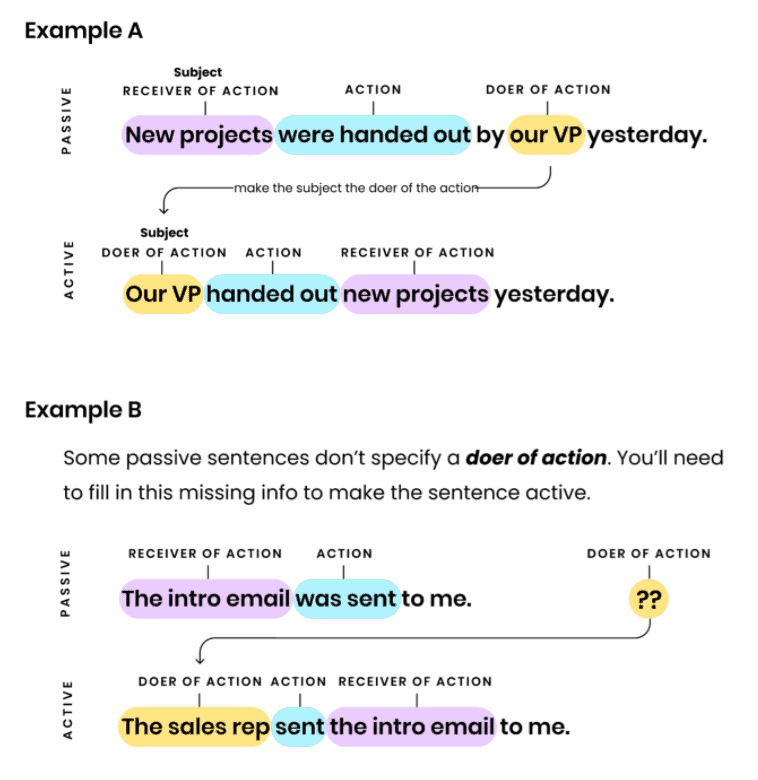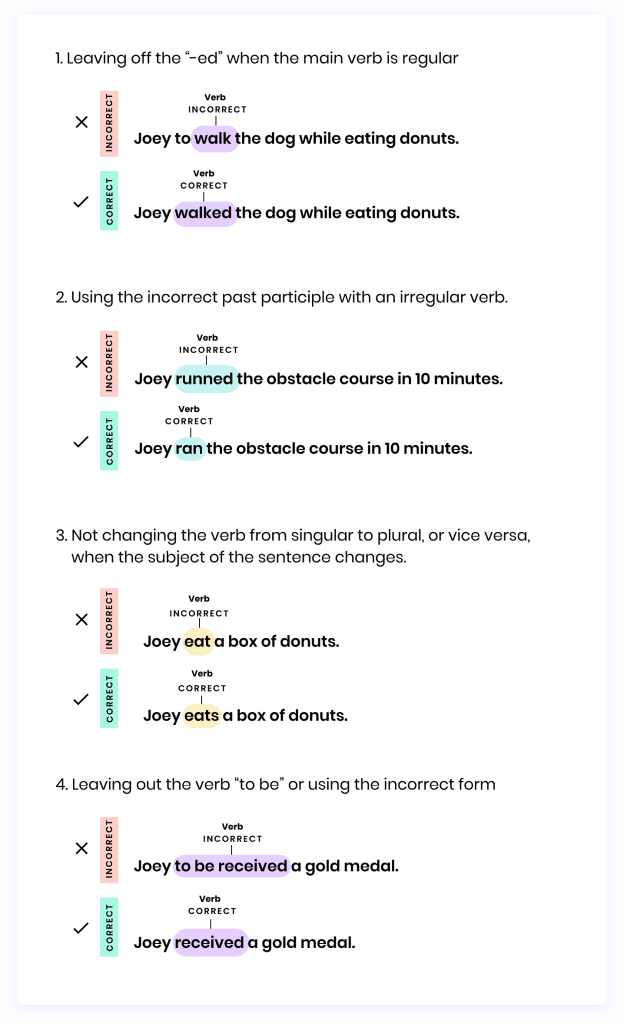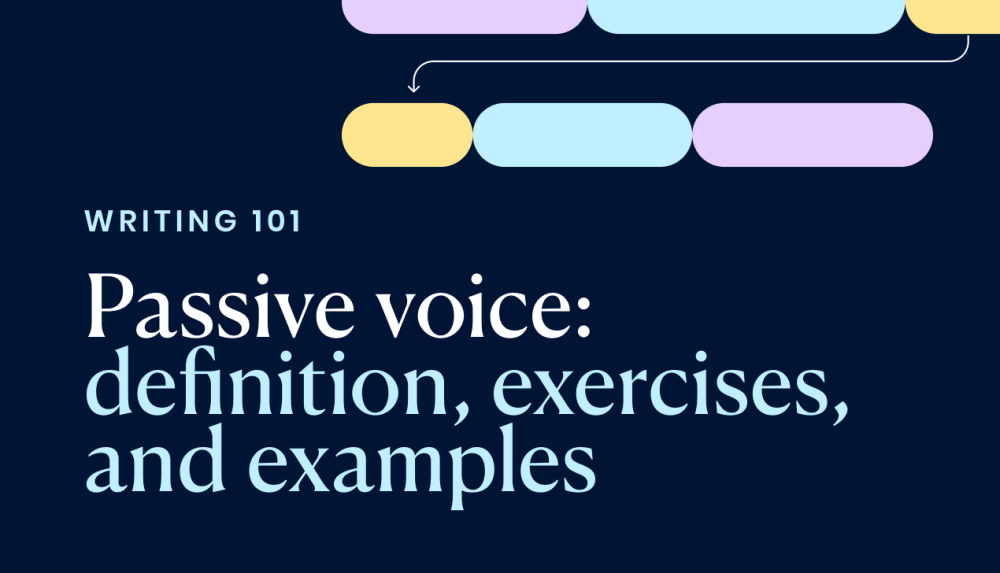My 10th grade English teacher hated the passive voice. I can still vividly remember seeing tons of giant red corrections on all my essays.
Chances are you likely had a writing instructor, teacher, or professor like mine growing up. They drilled it into your head that only bad writers use the passive voice. It is wordy, vague, and should be avoided like the plague – or COVID-19.
I’m here to debunk that myth. Using the passive voice isn’t a grammatical mistake. It’s a matter of stylistic preference.
In this post, I’m covering the ins and outs of the passive voice, including:
1. What is the passive voice?
2. What are the differences between active voice and passive voice?
3. Passive voice misuse
4. Passive voice exercises
5. Passive voice FAQ
What is the passive voice?
There are two primary writing formats: passive and active voice.
One of the simplest ways to tell if a sentence is in the passive voice is if you can add “to be” in front of the main verb. If this addition makes sense, then the the sentence is usually in the passive voice. If not, it is in the active voice.
Passive voice sentences tend to be wordier and can give your writing a more formal tone. However, this doesn’t mean that passive sentences have poor readability or shouldn’t be used. You just need to be careful of the context.
Before we dive into when to use the passive voice, here are a couple examples of what a passive sentence looks like:

What are the differences between active voice and passive voice?
The main difference between passive and active voice involves the subject of a sentence.
If the subject of the sentence is performing the action, then it’s in the active voice.
If someone or something is performing an action on the subject, then it’s in the passive voice.
This means the easiest way to check if a sentence is passive or active is to ask this question: “Who is taking action in the sentence?” If the goal is to write in a passive voice, then the subject of the sentence should not be the one taking action.
By looking at one of the passive voice examples above, we can view similar sentences written in both passive and active voice:
Passive: The project has been finished.
Active: Jane finished the project.
In the first sentence, the project is in the subject position, and it’s not taking the action. This makes it passive. In the second sentence, Jane is the subject of the sentence, is the one taking action. This makes it active.
Copywriters often argue that active voice is superior to passive. In many instances, it is. For example, persuasion and conversion copy can benefit from a direct, active verb that engages the reader. Active voice can also help the reader envision themselves taking action.
However, there are several instances where using a passive voice is more appropriate for the piece, such as in scientific writing and in contracts.
Passive voice misuse
Passive voice has its place in content and copywriting, but it is easy to overuse it.
In fact, Yoast recommends that no more than 10% of sentences in a given blog post use passive voice sentences.
For example, if you’re writing a sentence where a specific person is performing an action, it’s best to go with an active voice instead of passive.
If the subject is unknown, then it makes sense to go with a passive voice.
In addition, more formal writing – such as scientific writing, lab reports, or legal content – can also benefit from using the passive voice.
When using passive voice in your writing, here are four common mistakes to be aware of.

It helps to remember that all passive sentences have a form of the verb “to be.” However, just because a sentence includes it does not mean it’s automatically passive.
Perhaps one of the most famous examples of this is the miscategorized passive sentence by Strunk and White in The Elements of Style. They claimed this sentence was in passive voice because of the form “to be”: “There were a great number of dead leaves covering the ground.”
This was incorrect, and the sentence is actually in an active voice. Don’t make the mistake of calling a sentence passive only because it includes a passive form of the verb “to be.” Be sure to evaluate the entire sentence before determining whether it’s passive or active.
It’s worth noting again that the most common mistake with passive voice is using it when active voice should be used instead. If your definitive subject is performing an action, stick to an active sentence. Don’t go with a passive voice to fill a word count or because you think it sounds smart. There needs to be a reason for using passive voice.
Passive voice exercises
If you do a quick Google search for “passive sentence exercises,” you’ll find many free online handouts and passive voice exercise tools, such as this one from Perfect English Grammar. These tools are great for helping you understand passive voice use as well as the differences between passive and active voice.
However, my favorite passive voice exercise is “the zombie test.” If you aren’t sure whether your sentence is active or passive, add “by zombies” after the verb. If the sentence still makes sense, then it’s passive. If it doesn’t make sense anymore, then it’s active.
Check out the following example:
Passive: The lawn was mowed [by zombies] today.
Active: She paid [by zombies] her bills yesterday.
The first sentence makes sense with “by zombies” added, so it’s passive. The second sentence is in active voice and no longer makes sense when you throw zombies in it.
This exercise is meant to be a quick way to detect active and passive voice, so feel free to have fun with it and get creative.
Instead of zombies, you can use “Gritty,” “hamsters in Speedos,” or “radioactive dust bunnies.” It doesn’t matter what subject you choose, just pick something you can easily remember.
Are these sentences in the passive or active voice?
[quiz-cat id=”11277″]
Remember to be mindful of the type of writing you’re doing before determining if the active or passive voice is the best option for the piece. No matter whether you prefer active or passive voice, be sure to keep sentences as short and clear as possible. This ensures your content is easy to comprehend.
